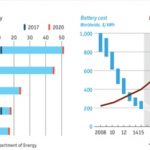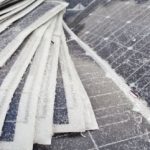Solar PV technology continues to innovate and evolve at a rapid pace. Testing the modules is essential for predicting durability and future performance. But that inevitably means past experience is not a good predictor of the behaviour of the new materials and configurations. Sara Fall and Harrison Dreves at NREL explain how the Durable Module Materials (DuraMAT) Consortium has set up sophisticated testing and data gathering to use the … [Read more...]
Hemp-based building materials: a low-carbon substitute for timber, concrete
How can we lower the lifetime emissions of building materials? Bernardino D'Amico at Edinburgh Napier University references his research to show how hemp-based materials can substitute for concrete. And it’s even more effective than timber, a popular low-carbon alternative. Growing industrial hemp can absorb twice as much CO₂ compared to growing trees. Raw hemp fibre can be processed into panels and mats for thermal or acoustic insulation. Hemp … [Read more...]
Buildings: how can Europe reduce emissions from Construction?
11% of global energy-related carbon emissions are embedded in the construction of buildings. Though focus has been on reducing operational emissions (28%, from heating and cooling, power etc.) there is not enough attention paid to construction, explains Carolina Kyllmann at CLEW. She looks at all the issues, including production of materials, transport to the site, construction, renovations, demolition and reuse of materials, and more. Kyllmann … [Read more...]
Building Materials “Embodied Carbon”: reaching net-zero with low-carbon cement, timber, modular design and more
In this explainer Madeline Weir, Audrey Rempher and Rebecca Esau at RMI first describe how embodied carbon is calculated. They then summarise the strategies being employed to reduce it, including using low-carbon, carbon-neutral, or even carbon-storing materials. New cement formulations are being developed with over 60% less CO2 emissions than the regular kind. Low-carbon mass timber is an alternative building material under development. On the … [Read more...]
Buildings “Energy Performance Certificates”: piloting new tools to ramp up renovations
In Europe, any building put up for sale or rent must have an Energy Performance Certificate (EPC). But as climate ambitions rise, so too must the those of the EPC. That's the purpose of the TIMEPAC consortium, funded by the EU’s Horizon programme, is working to extend its effectiveness and range of tools, explains Patricia Contreras Tejada writing for the European Science Communication Institute (ESCI). She quotes experts who point out that a low … [Read more...]
Factory-built energy-efficient modular affordable Housing for reducing lifecycle emissions
Building construction and operation accounts for 37% of global energy-related carbon emissions, according to the UNEP. And every part of the world needs new housing. The U.S. has a 3.8-million-unit housing shortage. Jeffrey Wolf, writing for NREL, describes how modular factory-made affordable net-zero housing is being developed that costs no more than existing construction methods. To get the greatest decarbonisation impact most cost-effectively, … [Read more...]
DoE study: 45% of U.S. power from Solar by 2050. How?
This month, the White House released a U.S. Department of Energy report, the Solar Futures Study, on how solar power could generate up to 45% of the U.S. electricity supply by 2050. It’s less than 4% today. Joshua Rhodes at the University of Texas at Austin looks at what obstacles must be overcome. The good news is that the technology and engineering is already available. And solar’s advantage is that the sun shines nationwide. Other region and … [Read more...]
What’s next for the geopolitics of energy transformation?
January’s IRENA report “A New World” has kick-started the debate on how the accelerating deployment of renewables will affect and alter the global distribution of political and economic power. Jan Frederik Braun and Daniel Scholten review its findings and build on the list of issues that must be faced. For example, although the IRENA report focuses on electrification the authors say power-to-gas is likely to play a major role, and we must face up … [Read more...]
Battery manufacture must take a global leap forward to ensure a sustainable and just transition
The global battery market is surging. By 2040 the global energy storage market is projected to attract $620 billion of investment. Over the past decade, the rechargeable lithium-ion battery market doubled on average every three years. To cope with this growth, we need the development of a sustainable and low-carbon value chain for batteries in order to contribute to the implementation of the 2015 Paris Climate Agreement, says Martin Brudermüller, … [Read more...]
Solar energy is green. Solar panels are not. AI can revolutionise their design
Solar panels are manufactured at 2,000˚C, a temperature so high it requires fossil-fuel power. They are also made using rare earth elements, the supply of which has both capacity and political issues. A new and global project is using artificial intelligence (AI) to rapidly create new designs with new materials that can make their manufacture greener and cheaper. The new designs may even bring their manufacture back to your home country, says … [Read more...]











